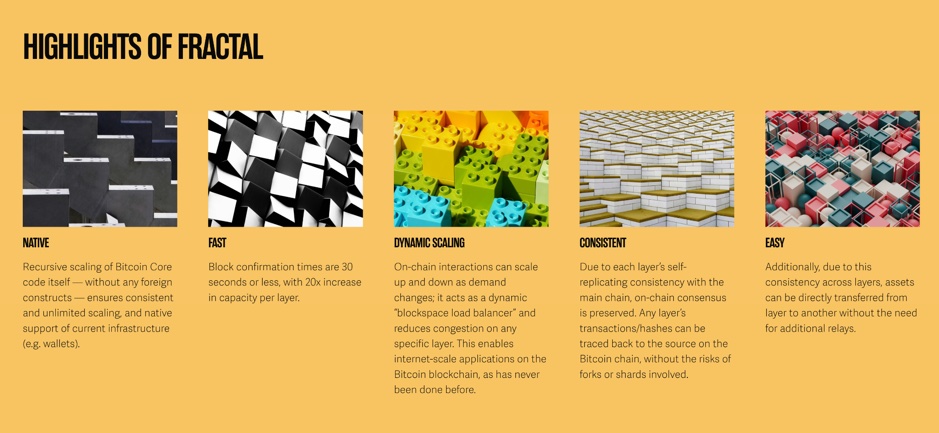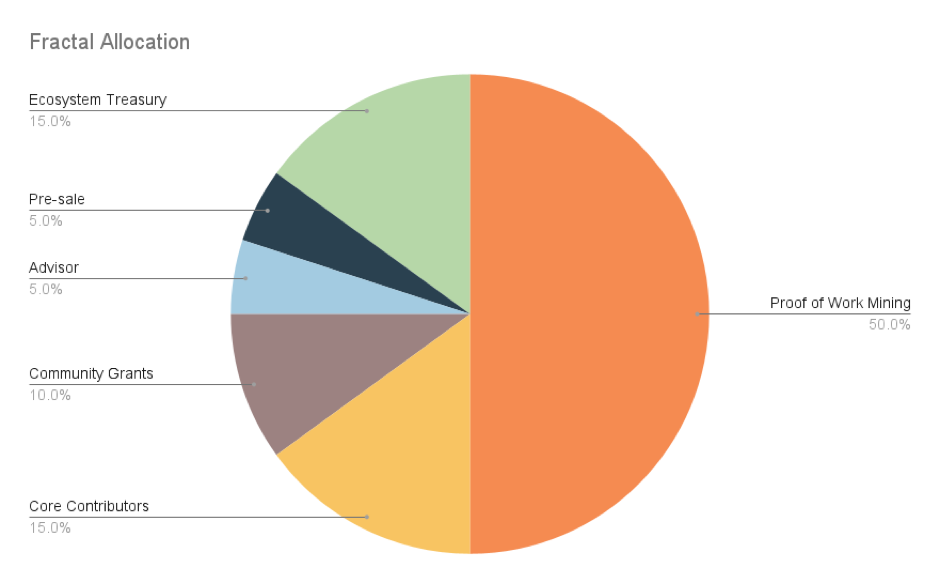What is Fractal Bitcoin? Why Should You Keep an Eye on It?
2024-09-09 09:56:00Key Points:
Fractal Bitcoin is a native Bitcoin scaling solution developed by the UniSat team for the Bitcoin network.
Fractal Bitcoin addresses key challenges of the Bitcoin network, such as slow transaction speeds, high fees, and limited scalability.
Fractal Bitcoin is fully compatible with Bitcoin and offers 20 times the transaction processing power of the main Bitcoin chain to allow it to handle significantly larger transaction volumes.
With the rising popularity of Bitcoin, issues like slow transaction speeds, high fees, and challenges in scaling have caught the attention of many developers. Over the years, numerous technical teams have worked to address these problems, resulting in a variety of solutions that have alleviated some of the issues within the Bitcoin network to varying extents. For instance, sidechain technology, which operates outside of the main Bitcoin network, improves transaction performance but doesn’t match the security level of the Bitcoin mainnet. Similarly, the RGB protocol leverages Bitcoin's security model to support the creation of tokens with customizable attributes and smart contract capabilities on the Bitcoin network. However, these solutions often require additional infrastructure or complex operations to implement, which can increase development costs and raise the barrier to entry.
In response to these challenges, Fractal Bitcoin proposes an infinitely recursive solution that significantly boosts the performance of the Bitcoin network without altering the core Bitcoin protocol or requiring major adjustments. How does Fractal Bitcoin achieve this? Let's dive deeper to understand the essence of Fractal Bitcoin.
What is Fractal Bitcoin?
Fractal Bitcoin, introduced by the UniSat team, is a native Bitcoin scaling solution designed to enhance the Bitcoin network. Fundamentally, it operates as a sidechain running in parallel with the Bitcoin network, connected through a specialized node (fractals). This architecture allows Fractal Bitcoin to maintain relative independence while benefiting from the security of the Bitcoin network. It remains fully compatible with existing Bitcoin wallets, tools, and miners.
The primary goal of Fractal Bitcoin is to significantly improve the performance of the Bitcoin network without altering the core Bitcoin protocol. Additionally, it aims to integrate a wide range of decentralized applications (Dapps) into the Bitcoin ecosystem, positioning Bitcoin as a thriving ecosystem on par with Ethereum.
To achieve this, Fractal Bitcoin introduces the concept of "fractals." In geometry, a fractal refers to a pattern that replicates and mimics a shape similar to the original, thereby preserving its key properties. Drawing on this idea, the UniSat team proposes encapsulating the core Bitcoin code to create an embeddable network expansion layer. This expanded network is linked to the main Bitcoin network recursively in order to allow each application to operate independently while ultimately feeding back into the main network.
In essence, this infinite recursion mechanism generates numerous independently operating networks, each capable of processing a high volume of transactions. These transactions are eventually consolidated and fed back to the main Bitcoin network for confirmation. This core mechanism leverages Bitcoin's own code to create a tree-like expansion structure, enabling each layer to further expand. As a result, the network's parallel processing power is dramatically increased which leads to faster transaction speeds and reduced transaction costs.
How Does Fractal Bitcoin Work?
Fractal Bitcoin represents a significant evolution in blockchain technology, offering a groundbreaking approach to enhancing the Bitcoin network's capabilities. By integrating advanced features such as recursive virtualization, a novel consensus mechanism, and cross-chain functionalities, Fractal Bitcoin aims to overcome the limitations of the traditional Bitcoin network. This new framework not only accelerates transaction speeds but also provides innovative tools for developers and miners, paving the way for a more efficient and scalable blockchain ecosystem. Below, we delve into the key components that define how Fractal Bitcoin operates and the unique technologies it brings to the table.
1. Recursive Virtualization (Concept from Fractal)
Fractal Bitcoin utilizes recursive expansion technology to establish multiple independently operating expansion networks on the Bitcoin blockchain. Each expansion network can be traced back to the source on the main Bitcoin network, thereby preserving the security and consensus mechanisms of the entire system.
This recursive expansion results in a tree-branch-like structure, characterized by layers of infinite extensions. This architecture enables each expansion network to be further extended, significantly enhancing transaction processing capacity and speed. According to official documentation, Fractal Bitcoin achieves a transaction confirmation time of just 30 seconds, which is 20 times faster than the Bitcoin main chain. By continually creating new expansion networks, Fractal Bitcoin effectively manages larger transaction volumes and data, preventing congestion on the main Bitcoin network. This efficiency has contributed to its recognition for superior performance.
2. Proof-of-Work (PoW) Consensus Mechanism
Fractal Bitcoin adopts the same proof-of-work (PoW) mechanism as Bitcoin, allowing miners to continue using existing ASICs, GPUs, and other mining equipment. Notably, Fractal Bitcoin introduces a mining method known as Cadence Mining, designed to balance merge mining with permissionless mining.

Source: Fractal Bitcoin Website
In the Fractal Bitcoin network, two out of every three blocks will be mined independently, while one block will be merged-mined with the main Bitcoin chain. This method ensures open, permissionless mining opportunities for the community, while also leveraging the strong security of Bitcoin’s main chain. Additionally, merge mining, starting after the genesis block—which generates 50 BTC to Satoshi Nakamoto's address (these funds remain inaccessible)—helps facilitate smooth block generation and offers protection against cyberattacks.
3. BRC-20 Token Standard
Fractal Bitcoin does not introduce new opcodes to enhance smart contract functionality, nor does it incorporate virtual machines. Instead, it re-enables OP_CAT to provide capabilities similar to those of smart contracts. Furthermore, Fractal Bitcoin permits all developers to issue and trade tokens on the network using the BRC-20 token standard. This approach addresses the challenge of expanding the Bitcoin network and lays the groundwork for the ecosystem's growth.
4. Multiparty Computation (MPC) Signature System
Fractal Bitcoin also incorporates a rotating MPC signature system, enabling users to securely and efficiently transmit various digital assets without the need for token encapsulation, thus preserving the integrity and availability of the assets.
5. MPC Cross-Chain Bridge
Fractal Bitcoin leverages MPC technology for cross-chain functionality which relies on trust assumptions similar to those of multisignature schemes. This approach significantly enhances the scripting capabilities of the Bitcoin network. The Fractal Bitcoin development team has indicated that methods for transferring assets from the main Bitcoin network to the Fractal Bitcoin network are currently under development, with approximately three to five traditional and innovative methods being explored.
What Are the Advantages of Fractal Bitcoin?
Fractal Bitcoin introduces a transformative approach to enhancing the Bitcoin network which offers several key advantages that redefine transaction efficiency, security, and scalability. In this section, we'll explore some of these benefits:

Source: Fractal Bitcoin Website
Enhanced Network Performance: Fractal Bitcoin offers superior network capabilities by maintaining 100% compatibility with Bitcoin while significantly improving transaction efficiency. With a block confirmation time of approximately 30 seconds, Fractal Bitcoin processes transactions at a rate 20 times faster than Bitcoin's main chain. Additionally, it provides 20 times more storage space per block, enabling it to manage a much larger volume of transactions compared to Bitcoin's primary network.
Consistent Security with Bitcoin Mainnet: The security and verifiability of Fractal Bitcoin are on par with the Bitcoin Mainnet, as all transactions within the Fractal Bitcoin network can ultimately be traced back to it. This ensures maximum resilience against cyberattacks, maintaining the robust security standards that Bitcoin is known for.
Adaptive Performance Load: Fractal Bitcoin dynamically adjusts its network layers based on current congestion levels, with each expansion network operating as an independent instance anchored to the main Bitcoin network. This adaptive approach allows Fractal Bitcoin to efficiently handle increasing transaction volumes and data loads without causing network congestion.
Reduced Transaction Costs: By enhancing transaction speeds and minimizing network congestion, Fractal Bitcoin significantly lowers transaction costs. This cost-effectiveness fosters the development of new applications on the Bitcoin network in order to enrich the ecosystem and potentially spark a new wave of transactions.
What is Fractal Bitcoin's Tokenomics?
Fractal Bitcoin functions as a sidechain of Bitcoin and has its own native token, FB. According to the official website, the total supply of FB tokens is capped at 210 million. Of these, 105 million tokens will be pre-mined, allocated to a usable address, and utilized for developer incentives, ecosystem development, airdrops, and various marketing initiatives. The remaining 105 million tokens will be generated through mining. However, the specific economic model governing these tokens has not yet been disclosed, and further details are pending updates.

FB Token Allocation, Source: Fractal Bitcoin
The FB token distribution strategy for the network is structured to ensure security, promote growth, and reward contributors across the ecosystem. Half of the total token supply is allocated to Proof of Work (PoW) mining, following a model similar to Bitcoin to maintain network security and block production. Fifteen percent is reserved for the Ecosystem Treasury to support ongoing ecosystem improvements, while 5% is dedicated to the pre-sale, aimed at early investors and covering initial development costs, with a six-month token lockup. Another 5% is allocated for strategic advisors, and 10% for community grants to establish partnerships and boost network engagement. Core contributors are assigned 15% of the supply, ensuring continued development and stability. This well-balanced tokenomics model promotes sustainability and security, offering incentives for participants and allowing for adjustments as the ecosystem evolves. Users are encouraged to participate in governance to help shape the network’s future.
When Will the FB Token Be Released, and How Can You Get the FB Token Airdrop?
At the time of writing, the Fractal Bitcoin network has yet to initiate the official release of its FB tokens. However, the network's testnet is active and has already garnered over 10 million active users. Preliminary reports indicate that participants in the testnet may be eligible for an airdrop of Fractal Bitcoin tokens, though this has not been officially confirmed.
Who is the Founder of Fractal Bitcoin?
Fractal Bitcoin was developed by the native team at UniSat, under the leadership of its founder, Lorenzo.
Conclusion
Fractal Bitcoin is a Bitcoin-native scaling solution developed by the UniSat team on the Bitcoin network. Not only is it rooted in the network's infrastructure and security, but it also introduces unique and innovative technology that could unlock limitless possibilities for the Bitcoin ecosystem. However, investors should note that the project is not yet live, and its future potential remains untested by the market. Therefore, it's crucial for investors to conduct thorough research before getting involved to make informed investment decisions.
FAQ
Q: What Are the Key Use Cases for Fractal in Bitcoin-Based Applications?
A: Fractal is designed to support stablecoins, DeFi solutions, large-scale games, and other applications native to Bitcoin. Its full compatibility with Bitcoin makes it an ideal platform for these innovations.
Q: How Does Fractal Bitcoin Differ From Other Bitcoin Scaling Solutions?
A: Fractal stands out due to its infinitely scalable framework based on Bitcoin Core Software. It is fully compatible with Bitcoin, supporting large-scale, internet-based applications seamlessly within the Bitcoin infrastructure.
Q: Why Is Fractal Important for Bitcoin's Scalability?
A: Fractal enhances Bitcoin's capabilities by providing a native scaling solution. Its focus is on being an extension of Bitcoin, enabling growth and adoption while remaining true to Bitcoin's core principles.
Disclaimer: The information provided in this article is intended only for educational and reference purposes and should not be considered investment advice. For more information, please refer to here Conduct your own research and seek advice from a professional financial advisor before making any investment decisions. FameEX is not liable for any direct or indirect losses incurred from the use of or reliance on the information in this article.